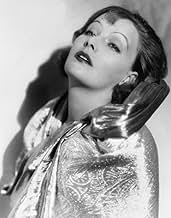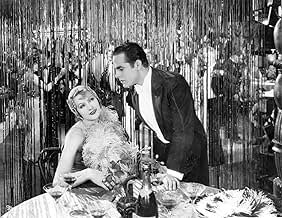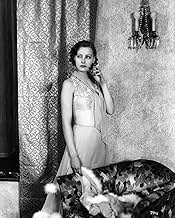NOTE IMDb
6,9/10
1,4 k
MA NOTE
Un architecte tente de réprimer sa passion pour une femme séduisante.Un architecte tente de réprimer sa passion pour une femme séduisante.Un architecte tente de réprimer sa passion pour une femme séduisante.
- Réalisation
- Scénario
- Casting principal
- Récompenses
- 3 victoires au total
Marc McDermott
- M.Fontenoy
- (as Marc MacDermott)
Robert Anderson
- Pirovani
- (as Robert Andersen)
Sam Appel
- Rebellious Argentine Workman
- (non crédité)
Helen Brent
- Undetermined Secondary Role
- (non crédité)
Steve Clemente
- Salvadore
- (non crédité)
Roy Coulson
- Trinidad
- (non crédité)
Louise Emmons
- Newspaper Vendor
- (non crédité)
Inez Gomez
- Sebastiana
- (non crédité)
Gale Gordon
- Dinner party guest
- (non crédité)
Bob Kortman
- Duras Henchman
- (non crédité)
Avis à la une
For Greta Garbo's second film under her new MGM contract the studio went back to the same source that they got for her first film with them Torrent. Vicente Blasco Ibanez offered up another of his novels for Garbo, The Temptress. Greta's got a whole lot of the men panting after her in this one.
Blasco Ibanez also gave us the slightly more familiar Four Horsemen Of The Apocalypse and Blood And Sand which served Rudolph Valentino well during the silent era. Garbo's character of Elena has a lot of similarity with Dona Sol in Blood And Sand. It ends a lot worse for Elena than for Dona Sol.
Garbo is married to Armand Kaliz who is not above peddling his wife's charms to get ahead. Right now she's got the wealthiest banker in Paris Marc McDermott in tow, but he means nothing to here but a cash cow for the husband. Who she really likes after meeting him at a costume party is Antonio Moreno, an engineer from Argentina who is looking for investors in a dam he wants to build.
After McDermott commits suicide when he's facing ruin and names Garbo as the one responsible, to escape until the notoriety dies down Garbo and Kaliz go to the Argentine Pampas and visit with Moreno. The local bully and bandit leader Roy D'Arcy takes one look at her and likes her and knows she's available in the right conditions. That sets up all the action for the remainder of the film.
Garbo's performance in The Temptress certainly assured her of a long career which was only briefly interrupted by the coming of sound where MGM took superb care to see that their investment transitioned smoothly. She is seductive and alluring in The Temptress like she was never before or since, even in her torrid film with John Gilbert Flesh And The Devil or in Mata Hari which calls for seductive and alluring like it calls for breathing.
Moreno was one of the first players to be known as Latin Lovers and he was about ending his career in those roles and would be transitioning to character parts. Roy D'Arcy as the bandit chief registers the best after Garbo. He had that Snidely Whiplash thing down pat and the silent screen certainly called for those overacted gestures. His career would continue in sound, but not as successfully. His duel with the whips with Moreno is as savage an encounter between hero and villain as you'll ever see on film.
The Temptress after over 80 years holds up well. For Garbo fans everywhere.
Blasco Ibanez also gave us the slightly more familiar Four Horsemen Of The Apocalypse and Blood And Sand which served Rudolph Valentino well during the silent era. Garbo's character of Elena has a lot of similarity with Dona Sol in Blood And Sand. It ends a lot worse for Elena than for Dona Sol.
Garbo is married to Armand Kaliz who is not above peddling his wife's charms to get ahead. Right now she's got the wealthiest banker in Paris Marc McDermott in tow, but he means nothing to here but a cash cow for the husband. Who she really likes after meeting him at a costume party is Antonio Moreno, an engineer from Argentina who is looking for investors in a dam he wants to build.
After McDermott commits suicide when he's facing ruin and names Garbo as the one responsible, to escape until the notoriety dies down Garbo and Kaliz go to the Argentine Pampas and visit with Moreno. The local bully and bandit leader Roy D'Arcy takes one look at her and likes her and knows she's available in the right conditions. That sets up all the action for the remainder of the film.
Garbo's performance in The Temptress certainly assured her of a long career which was only briefly interrupted by the coming of sound where MGM took superb care to see that their investment transitioned smoothly. She is seductive and alluring in The Temptress like she was never before or since, even in her torrid film with John Gilbert Flesh And The Devil or in Mata Hari which calls for seductive and alluring like it calls for breathing.
Moreno was one of the first players to be known as Latin Lovers and he was about ending his career in those roles and would be transitioning to character parts. Roy D'Arcy as the bandit chief registers the best after Garbo. He had that Snidely Whiplash thing down pat and the silent screen certainly called for those overacted gestures. His career would continue in sound, but not as successfully. His duel with the whips with Moreno is as savage an encounter between hero and villain as you'll ever see on film.
The Temptress after over 80 years holds up well. For Garbo fans everywhere.
Greta Garbo's second Hollywood feature is an irresistible meller, done to a turn by director Fred Niblo at his finest. (Dig those parallel tracking shots; first over a formal dining table laden w/ service & delicacies, and then under the same table, now heavy w/ service & delicacies of a rather different nature.) At this point in her career, Garbo was still playing femme fatale types (watch how she cups her lover's face in her hands) and in this adaptation of a rum Blasco-Ibanez novel, she drives four men to their ruin without lifting a finger. The plot takes us from Parisian highlife (a superb masked ball, a suicide at a banquet, overnight love in a park) down to the Argentine for dam building, a duel of honor played out with whips, sabotage & floods (with remarkable effects), and then back to Paris for our moral. When he's at his best, co-star Antonio Moreno is a bit like Brian Donleavy, alas he usually just looks vaguely surprised. But Roy D'Arcy & Lionel Barrymore get to whoop things up splendidly. Note that Garbo's regular lenser Wm Daniels shares credit with Tony Gaudio. But everyone deserves a prize, including one for the fine newly commissioned score.
This silent drama provides an interesting role for Greta Garbo, who was still rather young at the time. It also has some good set pieces created by directors Fred Niblo and/or Mauritz Stiller, which liven up the story considerably. The supporting cast also features a couple of good performances, and all of the strengths help to make up for a rather downbeat story.
As "The Temptress", Garbo is certainly believable as a woman who attracts the attention of every man around. What makes it more interesting than most such scenarios is that both the script and Garbo's performance leave some ambiguity about what the character is really like inside, and in any case she has a lot more depth than the male characters. The best supporting performances come from Lionel Barrymore and Marc McDermott, as two of the many men who desire her.
Several sequences are filmed very nicely. Fontenoy's dinner party is an effective display of the hollow lifestyle it depicts, and there is some real danger and menace in the fight scene between Robledo and Manos Duras. The pace overall is uneven, and it does have some slow stretches that add unnecessarily to the running time, but the good parts make up for this. At least one DVD version includes a variant ending that changes the tone considerably, so there must have been some uncertainty about how it should close.
Garbo's talent and screen presence are both easy to see, and in later features her characters would give her better opportunities to show them. She does a very good job here, and makes her character much more interesting than it would have been with a lesser performer in the role. Overall, it's a movie worth seeing for silent film fans, with some real highlights that make up for the occasional shortcomings.
As "The Temptress", Garbo is certainly believable as a woman who attracts the attention of every man around. What makes it more interesting than most such scenarios is that both the script and Garbo's performance leave some ambiguity about what the character is really like inside, and in any case she has a lot more depth than the male characters. The best supporting performances come from Lionel Barrymore and Marc McDermott, as two of the many men who desire her.
Several sequences are filmed very nicely. Fontenoy's dinner party is an effective display of the hollow lifestyle it depicts, and there is some real danger and menace in the fight scene between Robledo and Manos Duras. The pace overall is uneven, and it does have some slow stretches that add unnecessarily to the running time, but the good parts make up for this. At least one DVD version includes a variant ending that changes the tone considerably, so there must have been some uncertainty about how it should close.
Garbo's talent and screen presence are both easy to see, and in later features her characters would give her better opportunities to show them. She does a very good job here, and makes her character much more interesting than it would have been with a lesser performer in the role. Overall, it's a movie worth seeing for silent film fans, with some real highlights that make up for the occasional shortcomings.
"The Temptress" has a lot going for it, but it begins so sloooowly, and contains far too many intertitles.
I couldn't help thinking how much better it could have been with, maybe, Ernst Lubitsch or D.W. Griffith directing. This is supposedly a MOTION PICTURE, not a novel.
Still the directors gave us some wonderful shots and angles.
One particular sequence is told with a shadow! Superb.
And some running shots, with horses and a wagon, are worthy of the best of John Ford.
Then one particular action scene, a duel, is as exciting, and surprisingly graphic, especially for 1926, as one could hope for.
Still, overall, the story is somewhat dull and it's told often dully.
If it weren't for the chance to watch movie history, including early Garbo, and the action scenes, and the often interesting direction and photography, it might not be worth watching.
But it is, especially the new version at Turner Classic Movies, with a new score by young Michael Picton. Maestro Picton might well turn out to be a new Elmer Bernstein, who has -- it pains me to say -- passed on, but who was one of the greatest composers of the last 100 years.
I couldn't help thinking how much better it could have been with, maybe, Ernst Lubitsch or D.W. Griffith directing. This is supposedly a MOTION PICTURE, not a novel.
Still the directors gave us some wonderful shots and angles.
One particular sequence is told with a shadow! Superb.
And some running shots, with horses and a wagon, are worthy of the best of John Ford.
Then one particular action scene, a duel, is as exciting, and surprisingly graphic, especially for 1926, as one could hope for.
Still, overall, the story is somewhat dull and it's told often dully.
If it weren't for the chance to watch movie history, including early Garbo, and the action scenes, and the often interesting direction and photography, it might not be worth watching.
But it is, especially the new version at Turner Classic Movies, with a new score by young Michael Picton. Maestro Picton might well turn out to be a new Elmer Bernstein, who has -- it pains me to say -- passed on, but who was one of the greatest composers of the last 100 years.
This is a very good silent film, though I had just watched two other Greta Garbo films that were incredibly similar to this one--as she plays the vamp in all three! I can't blame Ms. Garbo for this, as MGM definitely type-cast her despite her objections. In fact, she was so irritated by this theme that she went on strike to try to force the studio to give her different roles. But, considering that the public loved the films and they were all very successful, MGM wasn't about to mess with a tried-and-true formula.
This film is at least a little different in that much of the time men were destroyed when they fell for Garbo in this film, but she was never directly responsible for their downfall. She was more like the old "Typhoid Mary" character--someone who just seems to have bad things follow her where ever she goes! The problem with this is that no matter how sultry and alluring Ms. Garbo might have been, no one is THAT seductive that man after man after man destroy themselves in order to try to get her! However, the story does have a few new elements and the overall production values are exceptional. So, if you view this film WITHOUT considering how derivative it is, then it's an awfully good film.
By the way, the TCM DVD includes an alternative ending that was apparently used when the film was shown in rural settings. Instead of the marvelous original but sad ending (that, in my opinion is perfect), there is an upbeat and sappy one that just doesn't ring true.
This film is at least a little different in that much of the time men were destroyed when they fell for Garbo in this film, but she was never directly responsible for their downfall. She was more like the old "Typhoid Mary" character--someone who just seems to have bad things follow her where ever she goes! The problem with this is that no matter how sultry and alluring Ms. Garbo might have been, no one is THAT seductive that man after man after man destroy themselves in order to try to get her! However, the story does have a few new elements and the overall production values are exceptional. So, if you view this film WITHOUT considering how derivative it is, then it's an awfully good film.
By the way, the TCM DVD includes an alternative ending that was apparently used when the film was shown in rural settings. Instead of the marvelous original but sad ending (that, in my opinion is perfect), there is an upbeat and sappy one that just doesn't ring true.
Le saviez-vous
- AnecdotesFootage of the dam being built is from the construction of the St. Francis Dam in Los Angeles County. The dam was completed in May 1926; it failed March 12, 1928, killing over 430 people.
- GaffesEarly in the whip fight, Manuel Robledo takes at least two direct "strikes" across his face; however, his face remains unmarked until later in the fight.
- Versions alternativesIn 2005, Turner Entertainment Co. copyrighted a version with a new musical score composed by Michael Picton. It was first broadcast on Turner Classic Movies (TCM) on 30 January 2005; it runs 106 minutes.
- ConnexionsFeatured in Hollywood (1980)
Meilleurs choix
Connectez-vous pour évaluer et suivre la liste de favoris afin de recevoir des recommandations personnalisées
- How long is The Temptress?Alimenté par Alexa
Détails
- Date de sortie
- Pays d’origine
- Langues
- Aussi connu sous le nom de
- The Temptress
- Lieux de tournage
- Saugus, Santa Clarita, Californie, États-Unis(St. Francis Dam under construction)
- Sociétés de production
- Voir plus de crédits d'entreprise sur IMDbPro
Box-office
- Budget
- 669 000 $US (estimé)
- Durée1 heure 2 minutes
- Couleur
- Mixage
- Rapport de forme
- 1.33 : 1
Contribuer à cette page
Suggérer une modification ou ajouter du contenu manquant

Lacune principale
By what name was La tentatrice (1926) officially released in India in English?
Répondre



































